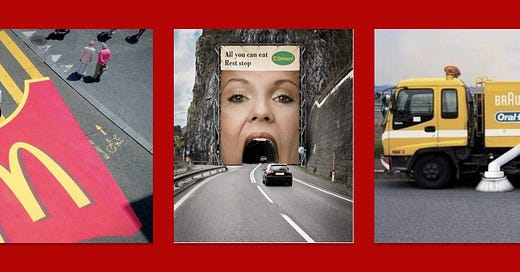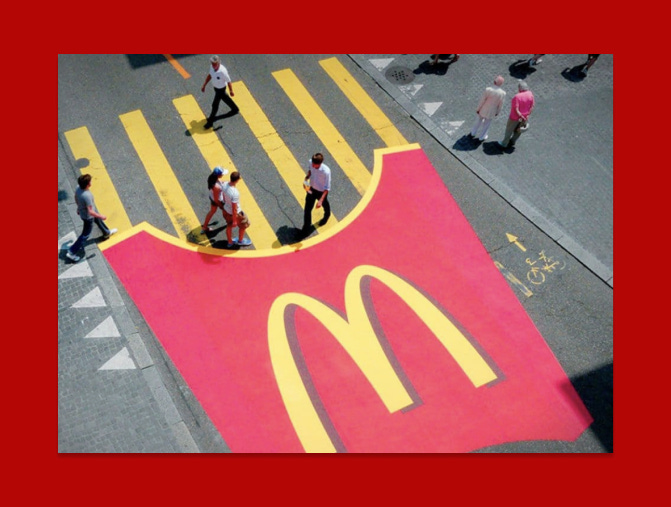Guerrilla marketing is an advertising approach that borrows the concept of “guerrilla” warfare, or the element of surprise, to communicate with target audiences. This form of marketing relies on unconventional and inventive displays to elicit wonder or shock and can be especially effective for driving publicity. (Coursera)
Have you ever seen guerrilla marketing in person, on your feed, or otherwise? At first, I marveled at these creative ventures. Captived by how much creativity and time it must’ve taken: brainstorming, creatives maneuvering through yards of red tape for corporate approval, tens of ideas shot down before one was selected. Many of these campaigns imitate art—paint disrupting the divide between 2D and 3D space with giant installations spilling from billboards into puddles covering everything within reach. Or maybe you’ve seen large sculptures of spilled coffee cups or popsicles that made you giggle at the scene’s absurdity.
Guerrilla marketing is meant to break through the noise of a world that promises us a constant dopamine source via thousands of short-form videos. I mean, these Ad people have lost the art of the jingle, how do they expect to keep our attention for more than five seconds? What began as a fascination and appreciation for how innovative the human mind can be quickly soured into cynicism and—frankly—disgust.
Look at the following image with the caption “Guerrilla Tactics Every Startup Should Know”:

I found this amid my hyperfixation on guerrilla marketing. The recoil I experienced when I saw the above image was unexpected but appropriate. Pictured is Che Guevara: a revolutionary and Former Minister of Industries of Cuba, killed by Bolivian soldiers who were, as you might’ve guessed, guided and equipped by the United States. He was a known Marxist, and now his image is used to pedal capitalist campaigns. CRAZY!
Then it hit me. Guerrilla marketing disgusts me because it is representative of so many vile things about our society: 1) the repurposing of creativity for capitalist gain (mind you—all while creatives are being yelled at online for pursuing “nonsense degrees”) 2) capitalism’s tendency to destroy anything oppositional to it, only to come out with a watered down copy that serves in furthering its profit-driven motives and 3) our inability to escape constant triggers to consume. I’m mainly going to be discussing my revulsion with number three.
Believe it or not, these ads represent a society encroaching on all of us, one where there is no escape from constant calls to consume. We could argue that this society is already here. After all, we can’t go a second of scrolling without a TikTok shop ad or even Googling something without the results being littered with advertisements from companies that have bought into the organization’s search engine monopoly. But still, the non-digital space remains relatively untouched by the constant invitations to spend more than we have. How often do you look up a product from a billboard or a subway ad? “Older” forms of advertising seem to not be cutting it in an age when our attention span can be bought for much less. They are still somewhat innocuous. Guerrilla marketing, on the other hand, changes our relationship with non-digital advertisements from passive to active.
Why sit on just any park bench when it can be a KitKat instead?
Why wait at any bus stop, when the Samsung one kindly coaxes you into believing that the phone you got less than a year ago needs replacing?!
Are we slowly heading toward a future where our public crossings will only be painted if a company pays to have its logo on it?
I know might be coming off like a fearmonger, but many things that should be public resources (like healthcare) are already at the mercy of private interests, why would our infrastructure be any different? We can ignore billboard ads, but intentional invasions of our physical space—giant temptations urging us to look, interact, and consume—seem inescapable. The installations are like those paintings with eyes that follow you from every corner of the room: intriguing, but eerie.
Our attention is monopolized by devices enough. The physical—non-digital—space is the only reprieve we have left from complete manipulation of our consumption habits. Is a future where every part of our lives, offline and online, is up for sale not dystopian for anyone else?
These excessive displays of grandeur remind me that we are indeed the product. Whichever company can develop an idea of how to monopolize our attention will succeed in increasing our consumption and their profits. If there is a single second we are not consuming then dollars are being lost, people! (I imagine that’s what they say in those rooms.)
It’s alarming that in just a few years—by the nature of how these things usually unfold—I could be running into these mockeries of art every five seconds. And yes, you and I may not fall for it, but there will be lots of people who are already in massive credit card debt that will lean into these displays. The younger generation—Gen Z and millennials— already have a massive debt problem. Yet, they are encouraged by constant advertisements to consume even more. I know what you might say: well, it’s their fault, they should stop buying. But, do they really stand a chance? In a society where material possessions are symbols of success, where many people live above their means to feign a lifestyle of pamper and glamour? A society where Klarna is our fairy godmother, appearing to soften the blow to our bank accounts only to slap us with outrageous fees? Do they—we—really stand a chance?
We all need a little personal accountability, but how do we maneuver through a world where one can’t even go to the park without being triggered to think about how much better the moment would be with a KitKat? The Che Guevara image above should show us all how easily capitalism absorbs and re-appropriates things to hold our attention and maintain us within its grip. Our will is being bought with no question, no escape, and it’s pissing me off. Pretty soon they’re gonna have holograms popping out of our TVs and sitting in the middle of our living rooms.
Sincerely,
A disgruntled patron of society.


![[ana]'s avatar](https://substackcdn.com/image/fetch/$s_!ctCW!,w_36,h_36,c_fill,f_auto,q_auto:good,fl_progressive:steep/https%3A%2F%2Fsubstack-post-media.s3.amazonaws.com%2Fpublic%2Fimages%2F7e5d6d12-3cbb-41e2-a0b3-2c26a266e23a_736x736.jpeg)





I’ve come to realize that a lot of emotional exhaustion/ mental fatigue ( at least for myself) comes from seeing advertisements whereever the hell I go!!! On the phone, before movies, on radios, on billboards in shop windows.
I live in a city with a ton of graffiti artists- people complain that they “ruin the city” but honestly I love it. I love seeing the new tags pop up, large phrases being painted in impossible places. It’s thrilling to watch art grow around you. The other day the city shit down four lanes of traffic to buff away some of the graffiti. Now the walls on the road lack colour and character- their life has been drained from them with tax money that should be going into ending the fentanyl crisis. It had me thinking about how graffiti is unacceptable but large billboards harassing us ( about literally anything) is fine and ok. Mass marketing via assumed consent is ( in my mind ) more destructive than someone spray painting “YoMama” on the walls lining the highway.
It’s perfectly fine for corporations to make advertisements that exploit the emotional processes of the human mind but not cool for some kid to make their mark in the world.
Amazing piece, has me thinking!
The Che Guevara one got me gasping so hard!!! I truly stopped staring at it for 5 seconds asking myself: did they really dare to use a prominent marxist figure, assassinated by neoliberal capitalists to promote "guerrilla marketing"?? and "guerrilla"?? Using marxist lingo when this system heavily demonises marxism is such a crime!!! I didn't even know such a term existed and I am baffled! Great article, though :)